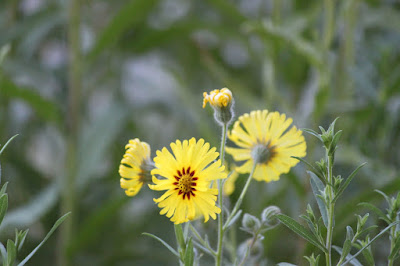When I lived in San Francisco I used to love going running with the Crowded House song "Four Seasons in One Day" on my iPod (which of course hadn't been invented yet and was really a crude little device we called a "walkman"), because no matter where in the city I chose to run, I would seem to travel through at least four seasons. It struck me hiking near my current East Bay home this weekend that the situation was similar, even though the temperature and relative humidity stayed pretty constant. Looking around though, I could indeed see samples of each of the four seasons, at least as we identify them in California.
The weather has been unseasonably cool this summer, even cool enough that my non-heat-loving Sweetie has been agreeing to hike with me--so I'm going to cheat a little and call this the hike's representative of winter. Also, cresting a large hill, a westward vista revealed a blanket of fog stretching itself along the coast toward Mount Tam and I knew all too well what it felt like for the people under it. There is a famous saying, often (but I've heard erroneously) attributed to Mark Twain: "The worst winter I ever spent was a summer in San Francisco." So I count that fog sighting as winter and summer both.

Then right underfoot I came across one, then another, impressive and stunning patch of Clarkias. I think it must be Clarkia affinis. The first is in semi-woodland, mixed with monkey flower, and the second is on completely exposed and sun-baked grassland. Its bloom time seems similar to Clarkia amoena, or Farewell to Spring, so it's natural to find it here in early summer. But as you can see by some of the photographed yet-to-unfurl buds, it's stretching its bloom time well, well into summer. I find it such a marvel that it manages to bring itself into existence among the nearly impenetrable mat of weedy grasses--all now crispy and dry as straw, another unmistakable emblem of the California summer.
I love the way the Clarkia petals catch the sunlight, like little chalices, and look so frail and dainty, even as one glance around the parched surroundings proves that they are in fact tough as nails.






For comparison, here is Clarkia amoena in my yard a couple months ago. I think the garden conditions might cause it to be a bit exuberant, and also the nurseries might tinker around with the gene pool a bit. Honestly? I like the rugged, no-frills little Clarkia in nature better.
Another cheerful and willing bloomer on the dry and sun-drenched path is my old friend Grindelia stricta. Last summer I grew this guy in my yard, but
wrote that I had to evict it because it just got too crazy. I had gumplants upwards of six feet in height; here in its natural home (a mere 2 miles away) it stays about knee-high, It's a cheery treat near the top of this hike's biggest climb, and it manages to bloom in spring and then way into summer. When I run this trail in the hot months, it's like a reward for making it to the top.


Next spring-summer spanning plant is Gnaphalium californicum. I am newly a huge fan. I have it in my yard for the first time this spring and have adored how it looks like little white lights among everything else. Up in the hills it grows in great patches and is at its most glistening and impressive now. In a few weeks, it will dry out but will remain quite lovely for a long time--hence its common moniker, Pearly Everlasting. On this hike, I see it in both stages.
Fresh spring look:


Mid-summer look:

Another spring flowerer I see soldiering on everywhere I look is good old monkey flower, Mimulus aurantiacus. In somewhat shaded areas on my hike, this plant looks as fresh as it must have in April. In my yard, it's pretty well gone into dormancy. I don't really know why all these plants I'm mentioning last longer in their natural homes than they do in my yard. Not like anyone's watering them out on the trail.

The fourth season, which I haven't got to yet, fall, is quite visible on much of the monkey flower, however. I find it so stunning to see the leaves turning scarlet, even as the yellow flowers are still fresh and bright.


What a lovely fall palette. And not too early, for us Californians. I find it pretty typical of the poison oak to be donning its scarlet wardrobe right about this time.

Another dazzlingly red denizen of this particular woodland is the spiny Ribes--it's not the speciosa that so many people put in their yards; I think it may be Ribes californicum or menziesii. At any rate, it's getting dressed for fall. The monkey flower, poison oak and Ribes know what some of us don't want to admit yet: fall is right around the corner.


Hike location:
http://www.ebparks.org/parks/sobrante_ridge






































